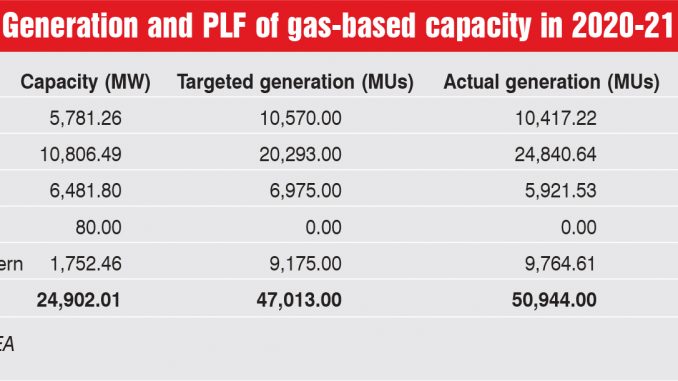
Gas can be an ideal transition fuel for the shift from coal-based generation to renewable energy in the Indian power sector. Gas-based power plants have the advantage of faster ramp-up with fewer intermittency issues. They also produce carbon emissions and offer better efficiency than coal-based power plants. However, for the past many years, the gas-based power segment has been stranded owing to the shortage of domestic natural gas supply, resulting in a low plant load factor (PLF) of 23 per cent. The installed gas-based capacity has not grown much in recent years and stands at about 24,924 MW, which is about 6.5 per cent of the total installed power capacity.
Current performance
The total gas-based power generation in the country stood at 50,944 MUs in 2020-21, about 5.16 per cent higher than the 48,443 MUs generated in the previous year. In 2020-21, over 6 GW of gas-based plants recorded zero power generation and the majority of these (5,703 MW) belonged to the private sector while a few (375 MW) were owned by the state sector.
The PLF of gas-based plants improved marginally to 23.34 per cent from 22.15 per cent during this period. While domestic gas shortage continues to affect the plants, a decline in international gas prices in 2020 due to the outbreak of Covid-19 led to a temporary increase in LNG supply and generation. As a result, the PLF increased to over 26 per cent during March-October 2020. However, as LNG prices gradually recovered, the PLF slid in the subsequent months.
Key developments
In October 2020, the central government shelved the proposed revival scheme for gas-based projects due to low global gas prices and the unwillingness of states to forgo taxes. The revival scheme was planned on the lines of an earlier scheme that was launched for the utilisation of gas-based power generation capacity in 2015-16 and 2016-17. The earlier scheme entailed the supply of imported spot regasified liquefied natural gas (RLNG) to the stranded gas-based plants and plants receiving domestic gas through the reverse e-bidding process. The scheme also envisaged compromises to be made collectively by all stakeholders and support from the Power System Development Fund. The scheme ended on March 31, 2017. The proposal to revive the e-RLNG scheme to provide support to gas-based power plants was examined in 2020 and the views of states were sought regarding waivers and concessions on state taxes and levies. The state governments opined against concession/waivers and exemption of goods and services tax for gas transportation under the scheme.
The Indian Energy Exchange (IEX) launched the Indian Gas Exchange (IGX), the first nationwide online delivery-based gas trading platform, in June 2020. Incorporated as a wholly owned subsidiary of the IEX, the IGX aims to enable market participants to trade in standardised gas contracts. It has been operating since December 2020 and falls under the regulatory framework of the Petroleum and Natural Gas Regulatory Board. With a competitive price discovery mechanism, the IGX may help in the revival of gas-based power plants, but it is still a long way before the market becomes efficient and facilitates a transition from state-determined pricing to market-based pricing given the low volumes and liquidity in the exchange.

Issues and the way forward
The shortage of domestic natural gas supply has been a key challenge for the segment ever since production from the much-awaited KG-D6 requirements. The situation has been compounded by revisions in the gas allocation policy, which have placed power plants lower on the priority list. This has led to stranded assets and a greater dependence on imports by operational plants, resulting in a higher generation cost and lower ranking in the merit order despatch list. Further, most of the power plants tend to operate on the paradigm of long-term power purchase agreements, which are not flexible in terms of the volatile fuel price movements.
As the availability of gas is uncertain, no new gas-based projects have been proposed as per the Central Electricity Authority’s (CEA) Optimal Generation Capacity Mix for 2030 report. Currently, only one gas-based power plant is under construction in the country – the 370 MW Yelahanka combined cycle power plant by Karnataka Power Corporation Limited.
However, given the role of gas-based power plants in providing flexibility to the system, which will be much needed to incorporate the increasing share of renewables, greater policy initiatives are required to salvage the segment.
